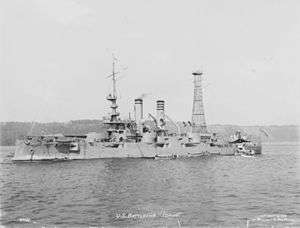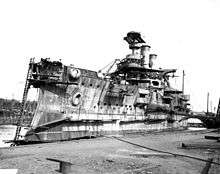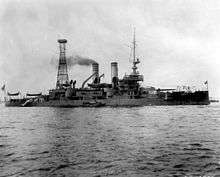USS Idaho (BB-24)
 USS Idaho on the Hudson River | |
| History | |
|---|---|
| Name: | Idaho |
| Namesake: | State of Idaho |
| Ordered: | 3 March 1903 |
| Builder: | William Cramp & Sons, Philadelphia |
| Yard number: | 328 |
| Laid down: | 12 May 1904 |
| Launched: | 9 December 1905 |
| Sponsored by: | Louise Gooding |
| Commissioned: | 1 April 1908 |
| Decommissioned: | 30 July 1914 |
| Struck: | 30 July 1914 |
| Fate: | Transferred to Greece, sunk by German aircraft, April 1941 |
| General characteristics [1] | |
| Class and type: | Mississippi-class battleship |
| Displacement: | 13,000 long tons (13,209 t) |
| Length: | 382 ft (116 m) |
| Beam: | 77 ft (23 m) |
| Draft: | 24.7 ft (7.5 m) |
| Speed: | 17 kn (31 km/h; 20 mph) |
| Complement: | 744 officers and men |
| Armament: | |
| Armor: |
|
USS Idaho (Battleship No. 24), the second ship of the Mississippi-class battleships, was the second ship of the United States Navy named in honor of the US state of Idaho. After her career in the USN, she was sold to Greece and renamed Lemnos in 1914. Lemnos was sunk by German bombers in April 1941. Idaho and her sister Mississippi were designed in response to Congressional desire to cap the growth and expense of new battleships, whose size and cost had increased dramatically since the first US battleships, the Indianas of 1893, had been authorized. Displacement was limited to 13,000 long tons (13,209 tonnes), a reduction of 3,000 long tons (3,000 t) from the prior Connecticut class.[2]
Design
In the early twentieth century, the US Navy was growing rapidly. The Navy commissioned its first battleships in 1895,[3] and by the middle of the next decade Jane's Fighting Ships ranked its battle line second only to the British Navy.[4] However, this rapid growth was not universally supported either within the government or within the Navy. Compromises between powerful groups were frequently necessary in order to get funding.[5]
The Mississippi-class ships were designed to meet Congressional and Navy Department objectives of reducing the escalating cost of new battleships, the quantity, size, and cost of which had increased dramatically over the first two decades of US battleship production.
Preliminary plans for the first two US battleships were completed in 1885. Construction was approved in 1886, and the first keel was laid down in 1888. However, technical difficulties, particularly with armor, delayed completion and neither was commissioned until 1895. By the time these were commissioned they were obsolete as newer, larger designs were being completed.[6] By the end of fiscal 1902 ten battleships and two second class battleships had been commissioned, with seven more battleships authorized but not completed.[7] The per-ship cost had doubled from the $4 million range for the Illinois class in the 1896 budget to nearly $8 million for Connecticut in the 1902 budget. The Mississippi-class ships would cost just under $6 million each.
There was a division among US naval planners in the early years of the 20th century over whether to have technically superior ships or many less expensive ones, with President Theodore Roosevelt among those supporting the former and Admiral Thomas Dewey along with Captain Alfred Thayer Mahan supporting the latter approach.[5]

The 1903 naval budget effected a compromise by calling for five ships: three more ships of the 16,000 long tons (16,000 t) Connecticut class and two ships of a new less expensive class of approximately 13,000 tons, with the design still to be determined.[5]
The ships that became the Mississippi class were intended to serve as the modern equivalent of 19th century third-rate ship of the line, offering what was thought to be an efficient compromise between sailing ability (speed, handling), firepower, and cost.[8] This concept had formed the backbone of the sailing battle fleets of the previous century, but trends in early twentieth century naval strategies were making the third-rate concept obsolete.[5] Prevailing strategies called for a consistent battle line of first-rate units.[8]
United States Navy

The second Idaho (Battleship No. 24) was laid down on 12 May 1904, at Philadelphia by William Cramp & Sons Ship and Engine Building Co. and launched on 9 December 1905. She was sponsored by Louise May Gooding, 13-year-old daughter of Idaho Governor Frank R. Gooding, and commissioned at the Philadelphia Navy Yard, League Island, on 1 April 1908, with Captain Samuel W. B. Diehl in command. Idaho departed Philadelphia in April 1908 for Guantanamo Bay, Cuba, via Hampton Roads. Following a shakedown off the coast of Cuba in 1908, she returned to Philadelphia for final fitting out and repairs. In the summer of 1908 she transported a detachment of marines to Colon in the Canal Zone to support a peaceful election process.[9]
Following a period of repairs at the Philadelphia Navy Yard, Idaho steamed to Norfolk, where she received a new "cage" mainmast tower, conducted testing of her guns out of Hampton Roads, and then returned to Philadelphia for more repairs and work.[9]

In early 1909 she joined Mississippi and other ships to meet the Great White Fleet upon its return and was reviewed by the President. For the remainder of the year and into 1910 she alternated between the waters off New England and southern waters, including the Caribbean and the Gulf of Mexico, along with a voyage in the Mississippi River and war games out of Guantanamo Bay.[9]
In late 1910 she sailed across the Atlantic with the Third Division of the Atlantic Fleet to Gravesend Bay, England, and then to Brest, France, returning to Guantanamo Bay in early 1911.[9]
After routine service with the Atlantic Fleet and in Cuban waters, Idaho departed Philadelphia on 4 May 1911, bound for the Gulf of Mexico and the Mississippi River. She visited the Louisiana ports of New Orleans and Baton Rouge, steamed past the mouth of the Red River, and visited St. Joseph. She called at Vicksburg and Natchez, Mississippi, in late May before visiting a succession of Louisiana ports.[9]
From mid-1911 to early 1913 she again performed routine service and maneuvers with the Atlantic Fleet and in Cuban waters, with periodic visits to Philadelphia for repairs.[9]
In February 1913, unrest in Mexico led to a coup d'état and the death of deposed President Francisco I. Madero. For the protection of American interests, Idaho deployed to Tampico in May and to Veracruz in June. She rejoined the fleet at Newport in late June. She then proceeded to the Philadelphia Navy Yard, where she was placed in the Atlantic Reserve Fleet on 27 October 1913.[9]
Idaho remained in reserve until recommissioned at Philadelphia in March 1914. At Annapolis, she embarked midshipmen bound for the Mediterranean in company with Missouri and Illinois.[9]
After visiting Tangier, Gibraltar, and Naples, Idaho arrived at the French port of Villefranche on 17 July 1914. The midshipmen were disembarked en masse to Maine, and Idaho was formally transferred to the Greek Navy on 30 July 1914.[9] The US received $12 million for her and Mississippi.[10]
Royal Hellenic Navy
Idaho decommissioned at the French port of Villefranche, and she was formally transferred to the Greek Navy on July 30, 1914. She remained in Greek service for 27 years, before being sunk during World War II.
Fleet designation
Although the Mississippi-class ships were decommissioned before the fleet designation reworkings in 1920, and thus never carried the "BB" hull classification symbol in service, many lists of American battleships (including the one in this encyclopedia) list them as "BB-23" and "BB-24" for completeness.
See also
References
- ↑ Chesneau, Koleśnik & Campbell 1979, p. 144.
- ↑ Reilly & Scheina 1980, pp. 186–187.
- ↑ Friedman 1985, p. 424.
- ↑ Rose 2007, pp. 12–14.
- 1 2 3 4 Friedman 1985, p. 44.
- ↑ Friedman 1985, pp. 17–21.
- ↑ Reilly & Scheina 1980, pp. 361–365.
- 1 2 Reilly & Scheina 1980, p. 187.
- 1 2 3 4 5 6 7 8 9 Cressman 2015.
- ↑ "To Two Battleships". The Independent. 20 July 1914. Retrieved 24 July 2012.
Bibliography
- Alden, John D. (1989). American Steel Navy: A Photographic History of the U.S. Navy from the Introduction of the Steel Hull in 1883 to the Cruise of the Great White Fleet. Annapolis, Maryland: Naval Institute Press. ISBN 0-87021-248-6.
- Chesneau, Roger; Koleśnik, Eugène M.; Campbell, N.J.M. (1979). Conway's All the World's Fighting Ships, 1860–1905. London: Conway Maritime Press. ISBN 0-85177-133-5.
- Cressman, Robert J. (21 July 2015). "Idaho". Dictionary of American Naval Fighting Ships. Navy Department, Naval History and Heritage Command. Retrieved 25 October 2016.
- Friedman, Norman (1985). U.S. Battleships, An Illustrated Design History. Annapolis, Maryland: Naval Institute Press. ISBN 0-87021-715-1.
- Hore, Peter (2007). Battleships. London: Anness Publishing Ltd. ISBN 978-0-7548-1407-8.
- Reilly, John C.; Scheina, Robert L. (1980). American Battleships 1886–1923: Predreadnought Design and Construction. Annapolis, Maryland: Naval Institute Press. ISBN 0-87021-524-8.
- Rose, Lisle A. (2007). Power at Sea The Age of Navalism, 1890–1918. Columbia, Missouri: University of Missouri Press. ISBN 0-08-262168-3.
External links
| Wikimedia Commons has media related to USS Idaho (BB-24). |
- USS Idaho (Battleship # 24), 1908–1914
- MaritimeQuest USS Idaho BB-24 Photo Gallery
- Photo gallery of Idaho at NavSource Naval History